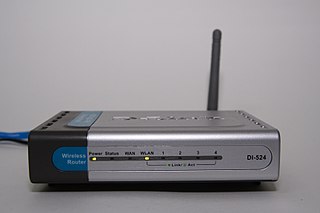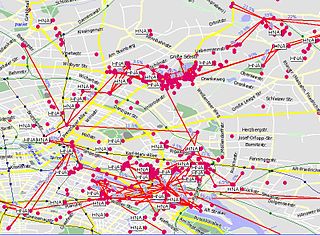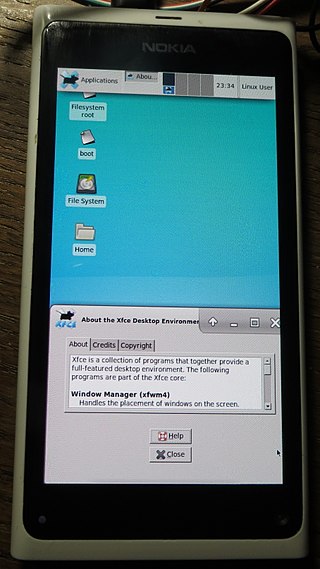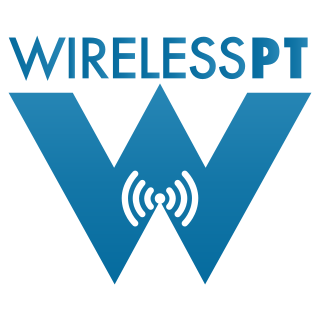Related Research Articles

Wireless community networks or wireless community projects or simply community networks, are non-centralized, self-managed and collaborative networks organized in a grassroots fashion by communities, non-governmental organizations and cooperatives in order to provide a viable alternative to municipal wireless networks for consumers.

In computer networking, a wireless access point, or more generally just access point (AP), is a networking hardware device that allows other Wi-Fi devices to connect to a wired network. As a standalone device, the AP may have a wired connection to a router, but, in a wireless router, it can also be an integral component of the router itself. An AP is differentiated from a hotspot which is a physical location where Wi-Fi access is available.

The Linksys WRT54G Wi-Fi series is a series of Wi-Fi–capable residential gateways marketed by Linksys, a subsidiary of Cisco, from 2003 until acquired by Belkin in 2013. A residential gateway connects a local area network to a wide area network.

A wireless router or Wi-Fi router is a device that performs the functions of a router and also includes the functions of a wireless access point. It is used to provide access to the Internet or a private computer network. Depending on the manufacturer and model, it can function in a wired local area network, in a wireless-only LAN, or in a mixed wired and wireless network.

Freifunk is a non-commercial open grassroots initiative to support free computer networks in the German region. Freifunk is part of the international movement for a wireless community network. The initiative counts about 400 local communities with over 41,000 access points. Among them, Münster, Aachen, Munich, Hanover, Stuttgart, and Uelzen are the biggest communities, with more than 1,000 access points each.

DD-WRT is Linux-based firmware for wireless routers and access points. Originally designed for the Linksys WRT54G series, it now runs on a wide variety of models. DD-WRT is one of a handful of third-party firmware projects designed to replace manufacturer's original firmware with custom firmware offering additional features or functionality.
The NSLU2 is a network-attached storage (NAS) device made by Linksys introduced in 2004 and discontinued in 2008. It makes USB flash memory and hard disks accessible over a network using the SMB protocol. It was superseded mainly by the NAS200 and in another sense by the WRT600N and WRT300N/350N which both combine a Wi-Fi router with a storage link.
In the context of free and open-source software, proprietary software only available as a binary executable is referred to as a blob or binary blob. The term usually refers to a device driver module loaded into the kernel of an open-source operating system, and is sometimes also applied to code running outside the kernel, such as system firmware images, microcode updates, or userland programs. The term blob was first used in database management systems to describe a collection of binary data stored as a single entity.
Piggybacking on Internet access is the practice of establishing a wireless Internet connection by using another subscriber's wireless Internet access service without the subscriber's explicit permission or knowledge. It is a legally and ethically controversial practice, with laws that vary by jurisdiction around the world. While completely outlawed or regulated in some places, it is permitted in others.
An electronic device or embedded system is said to be field-programmable or in-place programmable if its firmware can be modified "in the field", without disassembling the device or returning it to its manufacturer.
Linksys manufactures a series of network routers. Many models are shipped with Linux-based firmware and can run third-party firmware. The first model to support third-party firmware was the very popular Linksys WRT54G series.

The hacking of consumer electronics is an increasingly common practice that users perform to customize and modify their devices beyond what is typically possible. This activity has a long history, dating from the days of early computer, programming, and electronics hobbyists.
OpenWrt is an open-source project for embedded operating systems based on Linux, primarily used on embedded devices to route network traffic. The main components are Linux, util-linux, musl, and BusyBox. All components have been optimized to be small enough to fit into the limited storage and memory available in home routers.
DebWrt is a discontinued, niche Linux distribution mainly installed on embedded systems. It was built on top of an OpenWrt base which was used to load a fully functional version of Debian from the RootFS stored on the attached USB storage device. For easy installation and deinstallation of packages it relied on the dpkg Package management system. DebWrt used the command-line interface of Bash. There was no web-based GUI interface.

A PirateBox is a portable electronic device, often consisting of a Wi-Fi router and a device for storing information, creating a wireless network that allows users who are connected to share files anonymously and locally. By design, this device is disconnected from the Internet.

LibreCMC is a Linux-libre distribution for computers with minimal resources, such as the Ben NanoNote, ath9k-based Wi-Fi routers, and other hardware with emphasis on free software. Based on OpenWrt, the project's goal is to aim for compliance with the GNU Free System Distribution Guidelines and ensure that the project continues to meet these requirements set forth by the Free Software Foundation (FSF). LibreCMC does not support ac or ax due to a lack of free chipsets.

Wirelesspt is a non-commercial open grassroots initiative to support free computer networks that is not dependent of central infrastructure, corporation or entity which is done by the ordinary citizen provide free, open and democratic access to the highways of information technologies helping people and organizations implementing wireless networks that will benefit their communities.

Peter Daniel Eckersley was an Australian computer scientist, computer security researcher and activist. From 2006 to 2018, he worked at the Electronic Frontier Foundation, including as chief computer scientist and head of AI policy. In 2018, he left the EFF to become director of research at the Partnership on AI, a position he held until 2020. In 2021, he co-founded the AI Objectives Institute.
References
- 1 2 Spiegel, Dana (2012-11-27). "Share Your Network–Join New Open Wireless Movement". NYCwireless. Retrieved 2016-09-28.
- ↑ "Cerowrt Wiki - Bufferbloat.net".
- ↑ https://web.archive.org/web/20140821131637/https://openwireless.org/router/download
- ↑ "OpenWireless firmware project". GitHub. Retrieved 2016-09-28.
- 1 2 Eckersley, Peter (2015-04-15). "Three Paths to Better Open Wireless Routers". Electronic Frontier Foundation. Retrieved 2016-09-28.
- 1 2 Greenberg, Andy (2014-06-20). "This Tool Boosts Your Privacy by Opening Your Wi-Fi to Strangers". wired.com. Retrieved 2014-08-21.
- ↑ Silver, Joe (2014-06-20). "New open-source router firmware opens your Wi-Fi network to strangers". Ars Technica . Retrieved 2014-08-21.
- ↑ "OpenWireless.org". eff.org. Electronic Frontier Foundation. Archived from the original on 17 September 2020. Retrieved 26 August 2021.
- ↑ Eckersley, Peter (15 April 2015). "Three Paths to Better Open Wireless Routers". Electronic Frontier Foundation. Retrieved 26 August 2021.